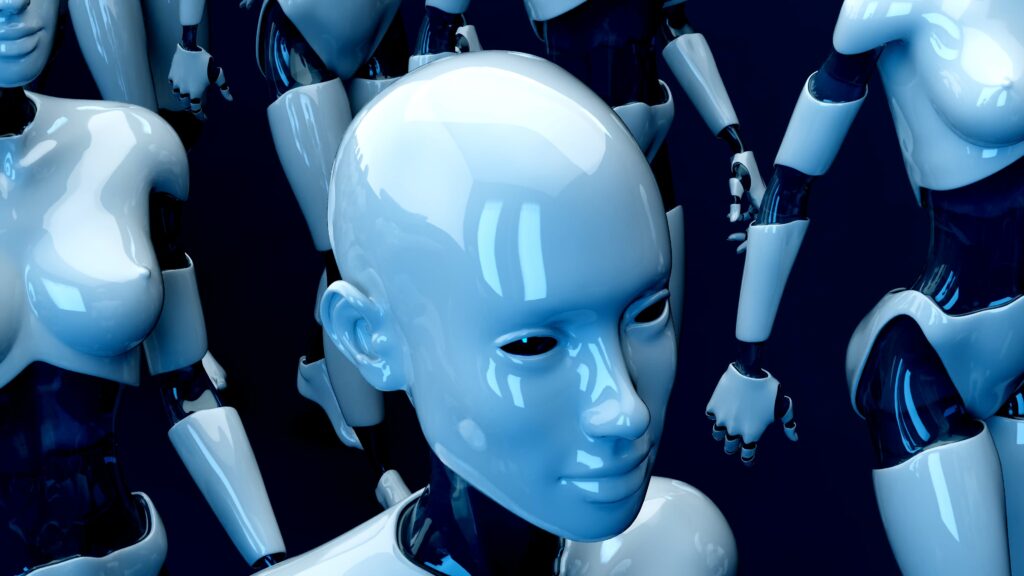Table of Contents
Wed, Nov 15, 2023 | 8 min read
Collaborative Intelligence: Humans and AI Go Hand-in-Hand in Business Automation

Karl Licayan
Growth
Table of Contents

The term ‘collaborative intelligence’ signifies the seamless blend of human intellect and artificial intelligence (AI) in orchestrating business automation efforts. It materially embodies the old proverb that ‘two heads are better than one’, only that one of these heads is AI. A virtual one that is designed to compute and respond at lightning speed.
It took a while, but the business world has finally woken up to the reality that humans and machines don’t have to be in opposition. In fact, 83% of IT leaders now believe that workflow automation is essential to digital transformation.
We’ve started moving away from the era of pitting humans against machines, or the ‘man versus machine’ analogy, towards an environment where they’re working in tandem, using their unique strengths to augment the capabilities of the other. In other words, it’s not an ‘either-or’ situation anymore; it’s more of a ‘better together’ perspective.
Advancements in AI, machine learning, and robotics have been strikingly impressive, and businesses are increasingly harnessing these technologies to automate routine tasks, augment decision-making processes, and amplify human potential. When coupled with the uniquely human attributes of creativity, critical thinking, and emotional intelligence, we get what’s known as ‘collaborative intelligence.’
Reflecting a new frontier in business automation, collaborative intelligence is lighting the way for unprecedented operational efficiency.

Introduction to Collaborative Intelligence
Collaborative intelligence refers to the new-age paradigm where human intellect and artificial intelligence (AI) work hand-in-hand towards a shared goal. A successful automation emphasizes a symbiotic relationship, relying on the strengths of both entities to form a powerful duo.
Principles of Collaborative Intelligence
The key value in collaborative intelligence lies in the premise of cooperation, not competition, between humans and machines. It isn’t about machines replacing humans, but rather about maximizing the unique strengths of both parties to create something far more impactful than each on their own.
Human Contribution vs AI Enhancement
In a collaborative intelligence model:
Humans contribute with their abilities to understand, interpret, and manage abstract concepts, creativity, intuitive judgement, ethical considerations, and other forms of ‘soft intelligence.’
AI, on the other hand, enhances this approach by providing rapid data processing, pattern recognition, accuracy, and consistency—capabilities that represent definitive forms of ‘hard intelligence.’
Collaborative Intelligence in Business
The synergy between human intellect and AI potential translates into a powerful model of operation that spurs growth, innovation, and progress in the business arena. This transformative approach goes beyond traditional business automation, setting the stage for a new era of operational efficiency.
Through the lens of collaborative intelligence, humans and AI are not adversaries but indispensable allies, each enriching the other to elevate businesses to new levels of efficiency and effectiveness.
Benefits of a Collaborative Intelligence Approach
In the quest for efficiency and sound decision-making, harnessing the power of collaborative intelligence offers distinct advantages.
Workflow Efficiency
Workflow efficiency is a notable benefit of the collaboration between humans and AI. Amplified by AI’s ability to handle large data sets and conduct repetitive tasks with accuracy, businesses are witnessing a significant boost in productivity.
For instance, AI-enabled chatbots can handle customer queries round the clock, freeing up time for human employees to focus on more complex tasks.
Humans can Focus on the Bigger Tasks
On the other hand, the role of human intellect remains indispensable. Humans bring on board their ability to think creatively and critically, skills that are crucial in decision-making processes. This collaborative approach removes the robot out of the human, and enables an enriched decision-making process. We can see AI providing data-driven insights, and humans using these insights to make informed decisions.
A case in point is the financial sector where robo-advisors offer investment advice based on algorithms. However, a human financial advisor brings into play their understanding of the customer’s individual circumstances and perceived risk tolerance, resulting in a personalized and comprehensive investment plan.
Real-world examples of businesses benefiting from collaborative intelligence are abundant. Take the example of Uber, for instance, which combines AI’s capabilities to predict demand and determine pricing with human drivers’ experience and judgment to navigate real-time traffic and ensure customer safety. This symbiotic relationship demonstrates how leveraging both AI and human intellect makes operations more efficient and productive.
At a time when the competition is intense, businesses are adopting a collaborative intelligence approach not just to survive, but to thrive. The unique blend of human skills and AI capabilities is a powerful tool driving business transformation and setting the stage for unprecedented growth.

Implementation of AI in Business Operations
One of the most noteworthy applications of collaborative intelligence is seen in the implementation of artificial intelligence (AI) in business operations. Businesses today, across various industries, are integrating AI into their key processes.
This enables everyone to develop a synergy between human capabilities and computational prowess to streamline tasks, mitigate inefficiency, and optimize results.
Digital Marketing
A case in point is digital marketing industries where predictive analytics, a subtype of AI, has been instrumental in providing real-time data, enabling companies to fine-tune their strategies instantly based on updated consumer behavior metrics.
Finance
Another example is the finance sector where automated trading systems leverage AI for decision-making in buying and selling assets. These systems analyze large volumes of data and deliver insights on complex market trends, enhancing decision-making and risk management processes.
E-commerce
The e-commerce sector exhibits a mammoth implementation of AI as well. From intelligent product recommendations based on customer buying patterns to AI chatbots providing efficient customer service, AI not only streamlines operations but also enhances user experience.
Cybersecurity
Investment in AI-based cybersecurity utilities is also on the rise. Here, AI helps to predict threats, detect anomalies, and devise mitigative solutions before the system is compromised, acting as a proactive defensive mechanism for businesses in the digital age.
It’s important to note that the end goal of incorporating AI in business management isn’t to replace human jobs but rather, to augment human capabilities. When paired with human expertise, AI can function beyond its programmed capacity, enabling businesses to scale operations, improve precision in tasks, and bolster decision-making potential.
This seamless incorporation of AI opens up new vistas for enhanced productivity and growth, placing businesses on the trajectory of success in an increasingly automated landscape.
Building a Culture of Automation with Collaborative Intelligence
To maximize the potential of collaborative intelligence, businesses must deeply embed a culture of automation into their organizational framework. This shift goes beyond just the implementation of AI technology within business processes; it also requires a drastic change in the mindset of individuals dwelling within the system.
The company’s team members need to welcome and adapt to the changes brought forth by automation. Only then can human intellect and artificial intelligence effectively intertwine to create a harmonious, efficient blend.
Implementation Starts at the Top
Initiation of this culture change starts from the top, usually in the boardroom. The top-tier management should perceive automation not as a disruption but as a strategic move toward higher productivity and optimized operations. Thereafter, this vision should percolate down to every stratum of the company.
Regular training and development sessions can be instrumental in equipping the workforce with necessary comprehension and skills to navigate the complexities of AI.
Overcoming Challenges, Together
However, this transition won’t come easy, and several challenges can arise during the shift. One notable hurdle is resistance to change from employees, often stemming from fear of job loss to automation. To address this, transparent dialogue about the intent and impact of automation can be helpful. It’s vital to communicate that AI is an enabler, not a replacement. It’s here to augment human capabilities, not to eradicate them.
Another common impediment is the lack of relevant skills among employees to work in tandem with AI systems. Here, businesses can solve through prioritizing reskilling and upskilling programs. Collaborative training that uses both AI and human coaches can help employees become more comfortable and proficient in using AI tools, eventually nurturing an environment where humans and machines work seamlessly together.
Fostering a culture of automation in business can indeed be a venture, but with the correct mindset, commitment, and approach, it can propel organizations into a future where collaborative intelligence flourishes, bringing forth unprecedented benefits.

Real World Examples of Collaborative Intelligence
Now that we’ve laid the theoretical groundwork, it’s time to explore some concrete examples that illustrate the successful application of collaborative intelligence in automation.
Amazon
Our first example takes us to the heart of eCommerce giant, Amazon. For years, Amazon has been capitalizing on the fusion of human dexterity and artificial intelligence for its warehouse management. The strategic deployment of robots for carrying stocks significantly fast-tracks the process, while humans step in for more nuanced tasks like packing delicate items and quality control.
The net result? An efficiency surge that translates to quicker deliveries and happier customers.
Toyota
Next, let’s jet over to Japan’s automobile behemoth, Toyota. Toyota has been a forerunner in using AI to predict maintenance patterns and enhance the efficiency of their assembly lines. Yet, it still leans heavily on the insights of its skilled human mechanics.
Leveraging the collaborative intelligence of machine learning algorithms and human expertise, Toyota can anticipate issues before they occur, proving that collaborative intelligence is as much about prevention as it is about solution.
If we pivot to the healthcare sector, Google’s DeepMind project offers a stellar example. By coupling AI algorithms with expert insights from medical professionals, the company developed an AI system capable of diagnosing eye diseases with the same accuracy as world-class doctors.
The AI provides rapid initial analysis, which is then reviewed and confirmed by a specialist, enhancing the speed and accuracy of diagnosis while preserving the irreplaceable personal touch of human medical professionals.
These varied examples underline the infinite potential of leveraging collaborative intelligence. Regardless of the industry, the seamless synergy between AI and human intellect appears to fine-tune operations, driving efficiency, and innovation.
We are standing at the precipice of a collaborative future where AI technology and human intervention intersect, presenting opportunities we’re just beginning to grasp.
Recap
The dynamism of today’s economy necessitates innovative measures in business operations, one of which includes the integration of collaborative intelligence.
The Power of Collaborative Intelligence
As we have reviewed, collaborative intelligence combines the power of artificial intelligence and human thinking, creating a potent force that enhances business automation. This unique approach ensures a seamless fusion of human skill and machine precision, paving the way for optimal operational efficiency.
Forward with AI
The AI revolution is progressively becoming a vital part of business operations, with an influence that is growing day by day. Whether it’s about:
Refining decision-making processes
Improving workflow efficiency
Solving complex business problems
AI is playing an undeniable role.
However, to fully leverage the power of collaborative intelligence, businesses must go beyond mere implementation. It’s about creating an automation culture, a shift that requires strategic decision-making, long-term commitment and consistent efforts.
This massive transformation does present its fair share of challenges. But as several real-world examples have shown us, the potential benefits far outweigh the disruptions.
In Conclusion
Collaborative intelligence is a powerful tool for businesses that are willing to adapt, innovate and ascend, particularly in the rapidly advancing automation realm. As a result, it presents a goldmine opportunity for businesses to stay relevant, competitive, and efficient.
So the question really is not about ‘if’, but ‘when’. The businesses that embrace automation wholeheartedly and foster a culture that encourages and sustains it, are the ones likely to flourish in this AI-driven era.
Want to level up your growth game? Get in touch now ->
Case Studies
- Content Marketing
- Print-on-Demand
- Conversion Rate Optimization
Resources
- Done-for-you systems
- Careers
